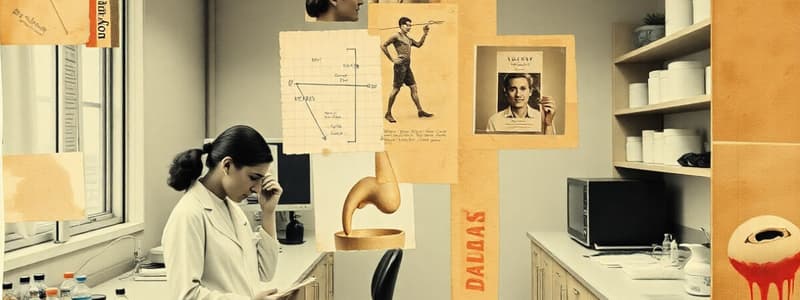Podcast
Questions and Answers
What is the primary responsibility of the person overseeing equipment management in a laboratory?
What is the primary responsibility of the person overseeing equipment management in a laboratory?
- Conducting all equipment maintenance personally
- Assigning responsibilities and monitoring equipment management activities (correct)
- Handling financial transactions for equipment purchases
- Leading safety training for laboratory staff
Which of the following is NOT included in the oversight of an equipment management program?
Which of the following is NOT included in the oversight of an equipment management program?
- Ensuring that all procedures are followed
- Reviewing equipment records routinely
- Performing daily maintenance on all equipment (correct)
- Updating maintenance procedures as necessary
When selecting laboratory equipment, which factor is essential to consider?
When selecting laboratory equipment, which factor is essential to consider?
- The past usage of similar equipment in other laboratories
- The availability of technical support in the area (correct)
- The potential resale value of the equipment
- The color of the equipment
What should laboratories consider if decisions about purchasing equipment are made externally?
What should laboratories consider if decisions about purchasing equipment are made externally?
Which of the following is a criterion for selecting laboratory equipment?
Which of the following is a criterion for selecting laboratory equipment?
What should laboratories know about reagents before acquiring equipment?
What should laboratories know about reagents before acquiring equipment?
Which of these factors is NOT considered when assessing the performance characteristics of laboratory equipment?
Which of these factors is NOT considered when assessing the performance characteristics of laboratory equipment?
If laboratory management believes equipment provided by donors is inappropriate, what should they do?
If laboratory management believes equipment provided by donors is inappropriate, what should they do?
What should be done with old equipment that has been fully retired?
What should be done with old equipment that has been fully retired?
Which item is NOT typically included in an equipment maintenance document?
Which item is NOT typically included in an equipment maintenance document?
What is the purpose of keeping good equipment records?
What is the purpose of keeping good equipment records?
What should be considered when disposing of equipment?
What should be considered when disposing of equipment?
What should be recorded as part of an equipment management program when a problem occurs?
What should be recorded as part of an equipment management program when a problem occurs?
How often should function checks of equipment be performed?
How often should function checks of equipment be performed?
Which of the following is NOT a typical tool used for keeping records on equipment management?
Which of the following is NOT a typical tool used for keeping records on equipment management?
What is included in the documentation for major equipment?
What is included in the documentation for major equipment?
What is a significant benefit of having a good equipment maintenance program in a laboratory?
What is a significant benefit of having a good equipment maintenance program in a laboratory?
What might be a consequence of neglecting the disposal of old equipment?
What might be a consequence of neglecting the disposal of old equipment?
Which of the following is essential for accurate test results in a medical laboratory?
Which of the following is essential for accurate test results in a medical laboratory?
Which of the following is an example of preventive maintenance documentation?
Which of the following is an example of preventive maintenance documentation?
What is emphasized as the most likely cause of centrifuge accidents when they occur?
What is emphasized as the most likely cause of centrifuge accidents when they occur?
What should the log book in a laboratory contain during the lifespan of the equipment?
What should the log book in a laboratory contain during the lifespan of the equipment?
What does a well-organized equipment management program in laboratories address?
What does a well-organized equipment management program in laboratories address?
What is a crucial aspect of maintaining laboratory equipment to promote safety?
What is a crucial aspect of maintaining laboratory equipment to promote safety?
What is the primary purpose of keeping capped tubes during centrifugation?
What is the primary purpose of keeping capped tubes during centrifugation?
What must be considered when loading the rotor of a centrifuge?
What must be considered when loading the rotor of a centrifuge?
Which of the following pipettes can handle a minimum volume of 200 microliters?
Which of the following pipettes can handle a minimum volume of 200 microliters?
What can happen if the pipette is used outside its specified volume range?
What can happen if the pipette is used outside its specified volume range?
How should the plunger be positioned to begin drawing up liquid in a pipette?
How should the plunger be positioned to begin drawing up liquid in a pipette?
Which of the following statements about micropipettes is true?
Which of the following statements about micropipettes is true?
What is a critical step before drawing liquid with a micropipette?
What is a critical step before drawing liquid with a micropipette?
What advancements have been made in centrifugation technology?
What advancements have been made in centrifugation technology?
What happens when the plunger of the pipette is pressed to the first stop?
What happens when the plunger of the pipette is pressed to the first stop?
What is the correct angle to hold the pipette when dispensing liquid into a tube?
What is the correct angle to hold the pipette when dispensing liquid into a tube?
Which of the following correctly describes the serial dilution process?
Which of the following correctly describes the serial dilution process?
When performing a 10-fold dilution, how is the solution mixed with the diluent?
When performing a 10-fold dilution, how is the solution mixed with the diluent?
What should be done after each pipetting event?
What should be done after each pipetting event?
To calculate the dilution factor when making a 1 mM solution from a 1 M stock solution, what is the result?
To calculate the dilution factor when making a 1 mM solution from a 1 M stock solution, what is the result?
At what depth should the pipette tip be immersed in the liquid for drawing it up?
At what depth should the pipette tip be immersed in the liquid for drawing it up?
What should be done if the pipette tip is submerged too deep into the liquid when drawing up?
What should be done if the pipette tip is submerged too deep into the liquid when drawing up?
Flashcards
Equipment Management Program Oversight
Equipment Management Program Oversight
Overseeing laboratory equipment, assigning responsibilities, training personnel, and monitoring activities.
Monitoring Activities
Monitoring Activities
Regularly reviewing equipment records, updating maintenance procedures, and ensuring procedures are followed.
Equipment Selection Factors
Equipment Selection Factors
Accuracy, reproducibility, facility requirements, cost, reagent availability, ease of operation, language support, retailer availability, warranty, and safety.
Equipment Maintenance Documents
Equipment Maintenance Documents
Signup and view all the flashcards
Equipment Logbook Records
Equipment Logbook Records
Signup and view all the flashcards
Centrifuge Safety Measures
Centrifuge Safety Measures
Signup and view all the flashcards
Micropipette Selection
Micropipette Selection
Signup and view all the flashcards
Drawing Up Liquid with a Micropipette
Drawing Up Liquid with a Micropipette
Signup and view all the flashcards
Dispensing Liquid with a Micropipette
Dispensing Liquid with a Micropipette
Signup and view all the flashcards
Serial Dilution
Serial Dilution
Signup and view all the flashcards
Serial Dilution Factor Equation
Serial Dilution Factor Equation
Signup and view all the flashcards
Serial Dilution Process
Serial Dilution Process
Signup and view all the flashcards
Study Notes
Equipment Management Program
- A dedicated individual should oversee all laboratory equipment.
- Oversight includes: - Assigning responsibilities for all activities, ensuring proper training for all personnel on equipment operation and maintenance, and monitoring management activities.
- Monitoring activities include: - Regularly reviewing equipment records, updating maintenance procedures as needed, and ensuring all procedures are followed.
- Daily maintenance should be the responsibility of the technical operator.
- All equipment users must receive training in calibration and daily maintenance.
- Lab managers should consult with technical experts to choose equipment that best suits the laboratory’s needs.
- If equipment is not meeting the needs of the lab, it should be disposed of in accordance with safety procedures.
- If equipment is replaced, be sure to salvage any useable parts.
Selecting and Acquiring Equipment
- Equipment selection should be based on the laboratory’s needs and services provided.
- Consider factors like: - Performance characteristics (accuracy, reproducibility), facility requirements, cost, reagent availability, ease of operation, language support, local retailer availability, warranty, and safety.
- For major purchases, laboratory managers should provide information that supports equipment selection to ensure the purchase meets the lab’s needs.
- Collaborate with national programs and donors when selecting equipment to ensure its suitability.
- When considering equipment acquisition, weigh the pros and cons of purchasing, renting, or leasing.
Equipment Maintenance Documentation
- Proper equipment documentation is critical to maintain a quality management system.
- Each piece of major equipment should have its own dedicated maintenance document.
- Smaller, commonly used equipment can be managed with a centralized document or manual.
- Equipment maintenance documents should include: - Step-by-step instructions for routine maintenance, function checks, calibration, troubleshooting, manufacturer service and repair, and a list of necessary items for use and maintenance (e.g., spare parts).
Equipment Logbook
- Every piece of equipment requires a dedicated logbook documenting key information.
- The logbook should record: - Preventive maintenance activities and schedules, function checks and calibration results, manufacturer maintenance activities, detailed information about any problems encountered, troubleshooting steps taken, problem resolution information, dates of equipment removal/return to service, and procedure changes resulting from any issues.
- Useful tools for keeping equipment records include: - Charts, logs, checklists, graphs, and service reports.
- The logbook should be readily accessible throughout the equipment’s lifespan.
Centrifuge Safety
- Centrifuge accidents are rare, but often caused by human error.
- Advancing centrifugation technology has integrated enhanced performance, ease of use, and safety features.
- To ensure safety: - Always balance opposing tubes by weight, ensure capped tubes remain capped during centrifugation, use centrifuge-savvy staff, and maintain proper centrifuge maintenance.
Micropipettes
- Micropipettes are available in different sizes, each designed to hold a specific volume range.
- When selecting a pipette, choose one that accommodates the desired volume.
- Follow proper pipetting technique to ensure accurate liquid transfer.
- Use sterile tips to maintain sterility.
- Adjust the volume using the adjustable wheel or plunger to the desired setting.
- Avoid exceeding the volume range of the pipette to prevent contamination and inaccurate results.
Pipetting Technique
- To draw up liquid: - Press the plunger to the first stop, hold the pipette vertically, dip the tip 3-4 mm into the liquid, and slowly release the plunger.
- To dispense liquid: - Hold the tip against the tube side at a 30-40 deg angle or beneath the surface of the liquid, and press the plunger to the second stop to ensure all liquid is dispensed.
- Dispose of tips after each use using the ejector.
Serial Dilution
- Serial dilution is a technique that allows for the quick and accurate dilution of a substance by a specific factor.
- First, determine the final volume and concentration needed.
- Calculate the dilution factor using the equation: Dilution factor = 1 / (final concentration / initial concentration).
- Choose appropriate dilution factors to create a series of dilutions.
- Serial dilution involves transferring a specific volume of the solution to a new tube containing a diluent (typically water).
- Repeat the transfer process with each tube to achieve the desired concentration.
Studying That Suits You
Use AI to generate personalized quizzes and flashcards to suit your learning preferences.




